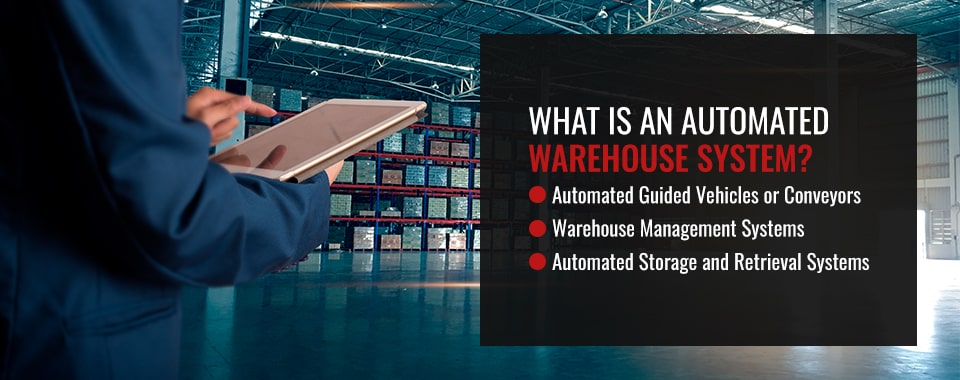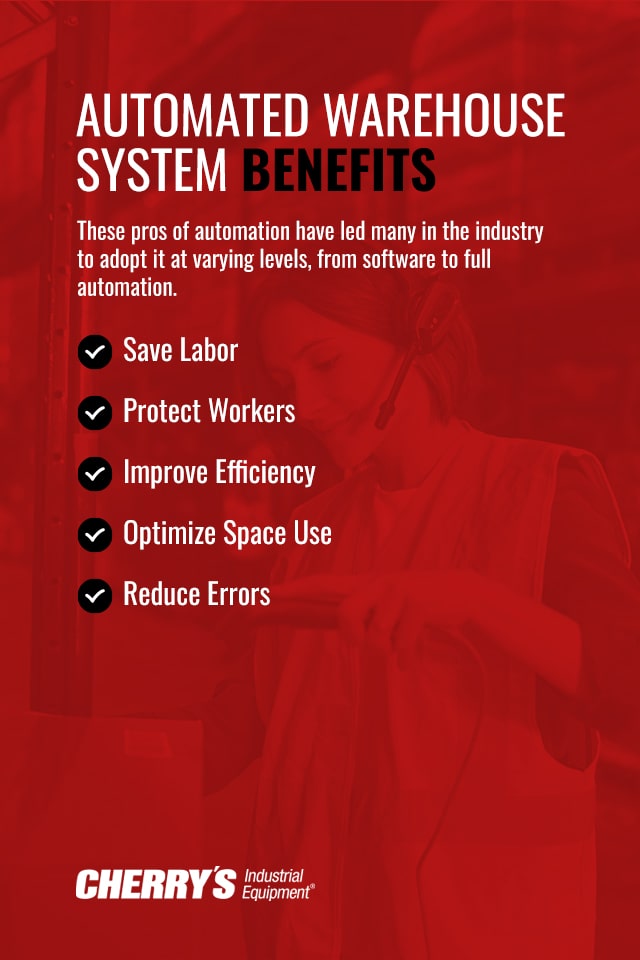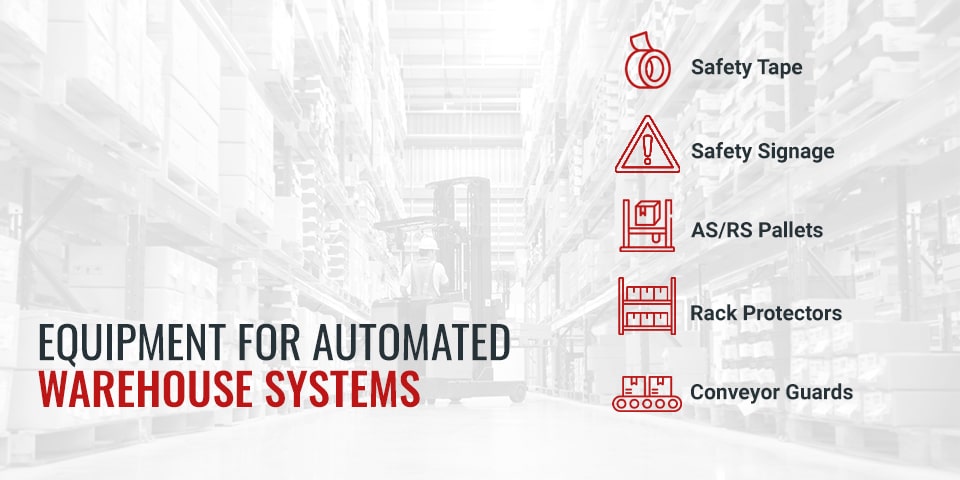
Automation has long been on the minds of those who manage warehouses. However, the technological innovations seem to have finally caught up to the industry’s needs in cost-effectiveness and efficiency. Not surprisingly, in 2020, 79% of warehouse managers reported that they would be “very likely” or “likely” to bring automation technology to their facilities within the next three years. With most businesses in the field making strides in automation adoption, your facility could get left behind if you continue using manual operations.
Jump to Sections:
- What Is an Automated Warehouse System?
- Automated Warehouse System Benefits
- Industries That Use Automated Warehouse Systems
- How to Implement an Automated Warehouse System
- Equipment for Automated Warehouse Systems
- Shop Cherry’s Material Handling for Equipment and More for Your Automated Warehouse

What Is an Automated Warehouse System?
Warehouse automation does not mean replacing all your employees with robots. Automation only takes over tedious, error-prone tasks with practical alternatives. You will still rely on a human workforce to run your warehouse’s daily operations. Moreover, those workers will become even more critical to ensuring the automated equipment runs efficiently.
Various types of automation exist for warehouses. Differences in these options include methods to reduce errors in movement, inventory, storage and retrieval.
Automated Guided Vehicles or Conveyors
First, automation in movement comes from vehicles that move without human drivers. Some vehicles require programming to adapt to the warehouse layout. However, automated guided vehicles may also travel using feedback from wires or lines placed around the facility. These vehicles can carry products from storage areas to shipping docks, reducing the time workers spend walking across the facility. They are versatile and can access more places than a conveyor belt.
Conveyor belts are another option for getting products from one end of the warehouse to another without requiring workers to put extra effort into walking or rolling it. These belts provide a useful entry point for facilities that need streamlined automation — 60% of facility operators said they plan to install conveyors or automatic sorting systems within three years of the 2020 survey they participated in.
Warehouse Management Systems
Another form of automation is software-based. Warehouse management systems are one of the most commonly used forms of automation. In 2020, 85% of logistics providers and warehouse managers used this software to track inventory and handle facility operations. Warehouse management systems offer solutions to maintain accurate inventory counts. Some products connect to worker-operated mobile tablets or other devices on the floor that update inventory as workers pick and pack products for orders. This level of accuracy and inventory tracking reduces errors and lost products that could cost your facility financially.
By automating operations — such as monitoring product progression through the warehouse, tracking inventory and offering data insights — WMS options can provide a powerful tool for improving warehouse efficiency.
Automated Storage and Retrieval Systems
Automated storage and retrieval systems represent the cutting edge of warehouse automation. This option uses robots to store products and pull orders. These systems require narrower aisles to accommodate only automated vehicles. Plus, you can keep products on much higher shelves with an AS/RS system. Consequently, facilities that use this system increase their storage space.
While this system requires considerable investment and training to get employees up to speed, it can offer significant returns. When used correctly, AS/RS can improve productivity by 85% and increase order retrieval accuracy to 99.9%.

Automated Warehouse System Benefits
When upgrading, understanding an automated warehouse’s advantages can put the cost into perspective. Automation saves labor, protects workers, improves facility efficiency, optimizes space use and reduces errors. These pros of automation have led many in the industry to adopt it at varying levels, from software to full automation.
Save Labor
Your warehouse will still need to have workers to keep operating. However, automation reduces the need for you to compete with other facilities to find additional employees. The logistics industry has suffered labor shortfalls at least since 2020. Between April 2020 and April 2021, the warehousing industry added 168,000 new jobs. However, during that period, individual payrolls created dropped by 4,300, indicating thousands of unfilled positions. Many companies have problems attracting, hiring and retaining enough workers to meet the industry’s growing demand. Automated warehouses could help ease this strain.
For instance, with automation, you reduce the need to recruit additional employees to fulfill orders. Even as your business grows, your current staff can work more efficiently in an automated warehouse, making your business less susceptible to labor issues. Robots can pull orders, while people pack them or maintain the automation equipment. Your warehouse will always need workers, but their positions, job descriptions and productivity will change when you add automation.
Protect Workers
Workers in automated warehouses benefit, too. They experience less physical strain because robots or other devices take over their repetitive, labor-intensive tasks. Since they don’t need to do the same motions constantly during their shifts, they reduce their chances of strain injuries.
However, don’t rely only on automation to prevent musculoskeletal injuries in workers. OSHA recommends avoiding repetitive motions, maintaining good posture and using powered lifting equipment to avoid warehouse-related injuries. For instance, conveyor systems may require workers to perform the same motions during their shifts. Even when using this automated solution, workers still need to learn how to avoid strain from working their stations. Training on workplace ergonomics can further protect workers from harm, even in automated facilities. Additionally, supervisors could schedule shorter shifts, rotate workers to different jobs or provide multiple breaks throughout the day to reduce the chances of strain.
Improve Efficiency
Automation improves efficiency by getting more done without wasted time or processes. As noted, productivity increases up to 85% in facilities that use AS/RS. The exact amount of efficiency and productivity improvement you will see depends on your current status and the types of automated equipment you bring into your facility.
Optimize Space Use
Automation makes your existing space more effective. For instance, with automated systems, you can use more storage closer to the ceiling because automated retrieval systems can safely reach much higher than human workers can. Plus, you can use narrower aisles if you will only have AGV or AS/RS in place because these robots don’t need much space to navigate down aisles. Consequently, your warehouse can fit more shelves into the same area.
Reduce Errors
Automated systems reduce human errors. Even simple systems such as barcode scanners that connect to inventory management can verify that the worker retrieves the correct product and updates the inventory. Fewer human errors can reduce the overhead cost you spend on lost products or inventory discrepancies.
Industries That Use Automated Warehouse Systems
There are many applications for automated warehouse systems throughout various industries. Basically, any facility that receives, stores, picks, packs, ships or handles returns can benefit from automating one or more of these processes, including warehousing, logistics providers, manufacturers, distributors, shippers and many others.
How to Implement an Automated Warehouse System
Implementing an automated warehouse system starts with planning. The initial stages involve discussions, plans and data collection to ensure you make the best investment for your facility. Because automation has high upfront costs, you will need to carefully calculate what your warehouse will most benefit from using.
Create a Plan That Includes Short-Term and Long-Term Automation Goals
Form a team that will plan the automation process, including members from finance, operations, floor managers and technology services. This group will set short- and long-term goals for your warehouse to help identify the best automated products to invest in.
Gather Data About Warehouse Operations
Gather data about how your warehouse operates, and use it to discover inefficiencies and places where upgrades can benefit your workers and productivity the most. Data collection and analysis will help the planning team decide what equipment to purchase.
Consider How You Manage Inventory
Many software-based aspects of automation involve inventory management. What system do you currently use? Find out if it fails to meet your facility’s needs and determine what you want to get from an inventory management system. Use this information to choose a warehouse management system that will help you keep operations at their peak and inventory counts accurate.
Choose and Use WMS
When choosing a WMS, find a model that is compatible with mobile devices to let your workers keep real-time inventory updates as they put away or retrieve products on the floor. The software should also be easy to use and compatible with other software you use to manage the warehouse.
Examine Your Facility Needs to Choose Automation
Lastly, use the information collected to identify the locations to maximize your investment in automation. When making your selection, balance your current budget with expectations and expected returns on the investment. For instance, if your facility does not have enough to invest in an AS/RS, consider conveyors or AGV instead. Or, you could upgrade from paper inventory management to digital. Even minor changes from manual to automated operations can give your warehouse considerable gains in productivity and efficiency.

Equipment for Automated Warehouse Systems
You don’t have to go all-in when automating your warehouse. Combining tried-and-true equipment with innovative automation products gives you the advantage of long-lasting, durable storage solutions with your automated gear. Even the highest-tech facilities will still need non-technical shelving, racks, signage, pallets and other supplies to store products and help employees work as efficiently and safely as possible.
Safety Tape
When combining human and automated machinery in a warehouse, people need to know where to go. Not all automated vehicles or robots can avoid obstacles in their set paths. Therefore, you need to place safety tape on the floors to create paths exclusively for foot and automated vehicle traffic.
Separating the two prevents accidents and ensures workers do not accidentally impede automated vehicles’ operation. This tape also works well for separating lanes of people-driven vehicles such as forklifts from foot traffic paths. Plus, if you need to alter your warehouse’s layout, you can easily remove the existing safety tape and create new paths to accommodate the changes.
Safety Signage
Safety signs are essential for organizing your facility, improving traffic flow and keeping workers safe. With signs, you quickly indicate the locations of lifesaving devices such as fire extinguishers or first-aid kits. Plus, these signs communicate permitted locations for people.
If you want to create an area of your warehouse exclusively for AS/RS, add signage to keep people out of the space. The extremely narrow aisles used for AS/RS do not permit people and robots to occupy the same space. Adding signs to keep people out of these aisles will ensure maximal efficiency from the system.
AS/RS Pallets
AS/RS systems require specialized pallets for the equipment to stock shelves or pull products from them. When choosing plastic AS/RS pallets, opt for fully recyclable pallets to reduce the waste your facility generates. These pallets are not only recyclable, but they are also capable of holding loads up to 30,000 pounds. Even if you don’t have automated equipment yet, you can still use these plastic pallets throughout your facility. Plus, they will work better than heavy wooden pallets when you get your AS/RS equipment.
Rack Protectors
Whether you have human-driven vehicles or automated ones, you should invest in rack protectors. These pieces fit at the bottom of the racks without impeding product access or aisle space. They protect workers by enhancing the racks’ stability and preventing incidents from occurring if a vehicle strikes the base of a rack. All rack protectors have proven effective at absorbing impacts from forklifts weighing 5,000 pounds and traveling at 3 mph.
Conveyor Guards
Conveyors are an earlier variation on automated vehicles. While these systems require set routes through the facility, they can reduce the walking required by employees. If you want to use conveyors as an automation solution, you need conveyor guards. Like rack protectors, conveyor guards prevent damage to the supports for the conveyor caused by vehicular impacts or people. These highly visible guards weigh 128 pounds or less for optimum portability. Your workers can move these guards wherever they need to place them.
Shop Cherry’s Material Handling for Equipment and More for Your Automated Warehouse
Take steps to upgrade your warehouse for current efficiency and future productivity. With the warehouse equipment we have, you can make your facility safer, more ergonomically friendly and maximally efficient. Integrate our solutions into your automation plans to gain the benefits of cost-effective solutions for today while you invest in future-focused technology.
Browse our wide selection of products designed to optimize your warehouse at Cherry’s Material Handling. With more than 35 years in the industry and using the products we sell in our storage facilities, we know we provide our customers with quality products for improving their warehouse safety, efficiency and productivity.